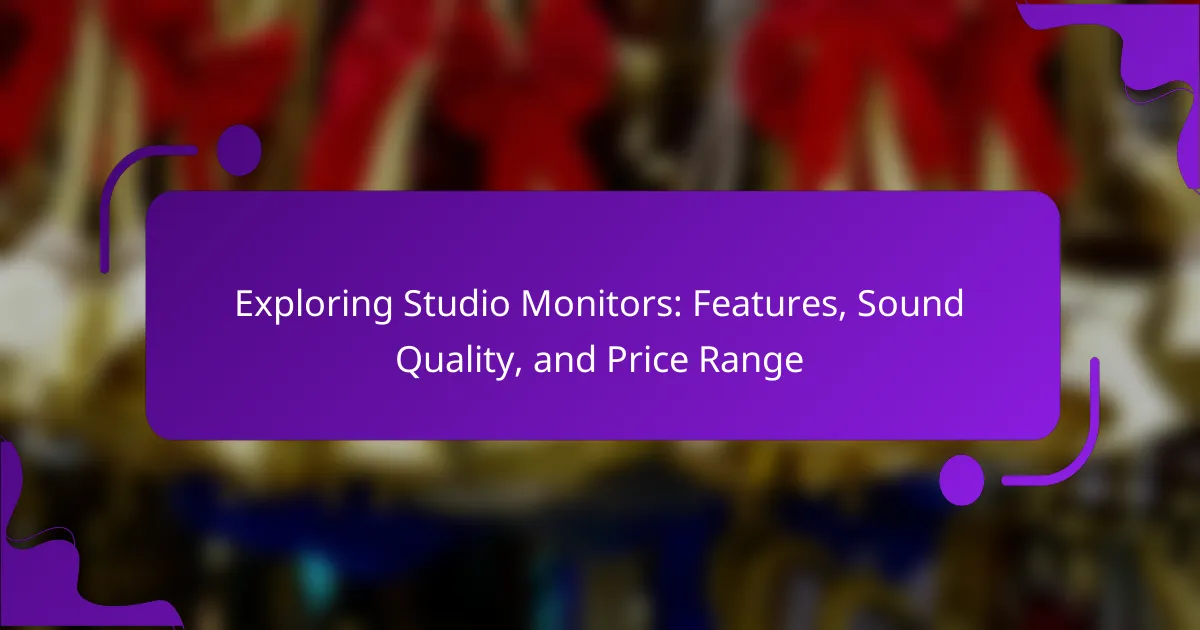Studio monitors are specialized speakers designed for audio production that ensure accurate sound reproduction, essential for mixing and mastering music. Unlike consumer speakers, they feature a flat frequency response, allowing producers to hear the true audio quality without coloration. Key metrics for evaluating studio monitors include frequency response, distortion levels, and dynamic range, which collectively determine sound fidelity and detail. The price range for studio monitors varies significantly, from budget options around $100 to high-end models exceeding $3,000, influenced by brand, size, and specifications. Popular brands like Yamaha and KRK offer affordable choices, while premium brands such as Focal and Genelec provide superior sound quality at a higher price point.

What are Studio Monitors and Why are They Important?
Studio monitors are specialized speakers designed for audio production. They provide accurate sound reproduction, which is crucial for mixing and mastering music. Unlike consumer speakers, studio monitors have a flat frequency response. This means they do not color the sound, allowing producers to hear the true audio quality. Accurate sound reproduction helps in making informed decisions during the mixing process. Poorly balanced monitors can lead to misjudgments in audio levels and effects. Therefore, using studio monitors is essential for achieving professional sound quality in recordings.
How do Studio Monitors differ from regular speakers?
Studio monitors are designed for accurate sound reproduction, while regular speakers prioritize enhanced sound quality and bass response. Studio monitors have a flat frequency response to ensure sound accuracy. This means they do not artificially boost any frequencies. Regular speakers often enhance certain frequencies for a more enjoyable listening experience.
Studio monitors typically have better build quality and components for professional use. They are engineered to minimize distortion at high volumes. Regular speakers may distort sound when pushed to their limits.
In a studio environment, accurate sound is crucial for mixing and mastering. The flat response of studio monitors helps audio professionals make informed decisions. Regular speakers are more suited for casual listening and entertainment.
What specific features set Studio Monitors apart?
Studio monitors are designed for accurate sound reproduction. They feature a flat frequency response, which means they do not color the sound. This allows for precise mixing and mastering in music production. Many studio monitors have bi-amped designs. This means they use separate amplifiers for low and high frequencies. This improves clarity and reduces distortion. Additionally, studio monitors often include adjustable EQ settings. These settings allow users to tailor the sound to their environment. The build quality is typically robust, ensuring durability for professional use. Lastly, studio monitors often have a larger driver size compared to standard speakers. This contributes to better bass response and overall sound fidelity.
Why is accuracy important in sound reproduction?
Accuracy in sound reproduction is crucial for delivering true-to-life audio experiences. Accurate sound reproduction ensures that listeners hear music and sounds as they were intended by the creators. It allows for precise mixing and mastering in studio environments. When sound is reproduced accurately, it reflects the original recording’s tonal balance, dynamics, and spatial characteristics. This fidelity enables producers and engineers to make informed decisions during the production process. Research shows that accurate sound reproduction can significantly improve listener satisfaction and engagement. Studies indicate that listeners prefer systems that provide a true representation of sound over those that color or distort it.
What are the key features of Studio Monitors?
Studio monitors are specialized loudspeakers designed for audio production. They provide accurate sound reproduction, essential for mixing and mastering. Key features include flat frequency response, which ensures that all audio frequencies are reproduced equally. This prevents coloration of sound, allowing producers to hear the true quality of their recordings. Another feature is bi-amplification, where separate amplifiers power the bass and treble drivers. This enhances clarity and reduces distortion. Additionally, studio monitors often include adjustable EQ settings for tailoring sound to specific environments. They also feature a robust build quality to withstand studio use. Many models come with a variety of input options, such as XLR and TRS, ensuring compatibility with different audio interfaces.
How do driver size and type affect sound quality?
Driver size and type significantly affect sound quality in studio monitors. Larger drivers typically produce deeper bass frequencies. They also handle higher sound pressure levels without distortion. Smaller drivers excel in producing higher frequencies with clarity. Different driver types, such as dynamic, ribbon, and electrostatic, have unique sound characteristics. For example, ribbon drivers offer a smooth response and wide dispersion. In contrast, dynamic drivers are more common and versatile. The combination of driver size and type influences overall tonal balance and accuracy. This relationship is crucial for accurate sound reproduction in studio settings.
What role does frequency response play in performance?
Frequency response significantly influences audio performance. It defines how accurately a studio monitor reproduces sound across various frequencies. A flat frequency response ensures that all frequencies are represented equally. This accuracy is crucial for mixing and mastering music. Monitors with a wide frequency response can capture both low and high frequencies effectively. For instance, a monitor with a frequency response of 20 Hz to 20 kHz covers the full range of human hearing. This capability allows producers to make informed decisions about their mixes. Poor frequency response can lead to misleading sound representation. Consequently, accurate frequency response is essential for achieving high-quality audio performance.
How does amplifier power influence overall sound output?
Amplifier power directly influences overall sound output by determining the volume and clarity of the sound produced. Higher power ratings allow amplifiers to drive speakers more effectively. This results in a louder sound without distortion. For example, a 100-watt amplifier can produce significantly more volume than a 20-watt amplifier. Additionally, adequate power helps maintain sound quality at higher volumes. Insufficient power can lead to clipping and reduced audio fidelity. Therefore, selecting a suitable amplifier power is crucial for achieving optimal sound performance in studio monitors.
What factors influence the price of Studio Monitors?
The price of studio monitors is influenced by several key factors. These factors include brand reputation, sound quality, build quality, and features. Brand reputation affects pricing due to perceived quality and trust. Sound quality is determined by frequency response, clarity, and distortion levels, which impact performance. Build quality relates to materials used and durability, affecting longevity and reliability. Additional features, such as connectivity options and built-in DSP, can also increase the price. Furthermore, size and power output play a role in pricing. Larger monitors typically cost more due to enhanced sound capabilities. Finally, market demand and competition can influence pricing trends within the industry.
How do brand reputation and market positioning affect pricing?
Brand reputation and market positioning significantly influence pricing strategies. A strong brand reputation allows companies to command higher prices. This is because consumers associate reputable brands with quality and reliability. Market positioning also plays a crucial role. Brands positioned as premium often set higher prices to reflect their perceived value. For example, high-end studio monitor brands leverage their reputation to justify costs. According to a study by the Journal of Marketing Research, brands with strong reputations can charge up to 20% more than lesser-known competitors. Thus, both brand reputation and market positioning directly impact pricing structures in the market.
What impact do features and specifications have on cost?
Features and specifications significantly impact the cost of studio monitors. Higher-quality materials and advanced technology typically increase production costs. For example, monitors with larger woofers provide better bass response but are often pricier. Additionally, features like built-in DSP (Digital Signal Processing) can enhance sound quality, leading to higher prices. Specifications such as frequency response range also affect costs; wider ranges often indicate superior performance. Brands with established reputations for quality may charge more due to perceived value. Ultimately, the combination of these factors results in a direct correlation between features, specifications, and the overall cost of studio monitors.

How is Sound Quality Measured in Studio Monitors?
Sound quality in studio monitors is measured using several key metrics. These include frequency response, distortion levels, and dynamic range. Frequency response indicates how accurately a monitor reproduces sound across different frequencies. A flat frequency response is ideal for mixing and mastering. Distortion levels measure how much the original signal is altered. Lower distortion indicates higher sound fidelity. Dynamic range assesses the difference between the quietest and loudest sounds the monitor can produce. A wider dynamic range allows for more detail in audio playback. These metrics are essential for evaluating studio monitors’ performance.
What metrics are used to evaluate sound quality?
Metrics used to evaluate sound quality include frequency response, total harmonic distortion, and signal-to-noise ratio. Frequency response measures the range of frequencies a sound system can reproduce. It is typically represented in Hertz (Hz) and indicates how well a system can handle low and high frequencies. Total harmonic distortion (THD) quantifies the distortion in a signal as a percentage. Lower THD values indicate clearer sound reproduction. Signal-to-noise ratio (SNR) compares the level of a desired signal to the level of background noise. A higher SNR means better sound clarity and quality. These metrics are essential for assessing the performance of audio equipment.
How do THD (Total Harmonic Distortion) and SNR (Signal-to-Noise Ratio) relate to sound clarity?
THD (Total Harmonic Distortion) and SNR (Signal-to-Noise Ratio) significantly impact sound clarity. THD measures the distortion in a signal relative to the original, with lower values indicating clearer sound reproduction. For instance, a THD of 0.01% is preferable for high-fidelity audio. SNR quantifies the level of the desired signal compared to background noise. A higher SNR, such as 90 dB, suggests minimal noise interference, enhancing clarity. Together, low THD and high SNR ensure that audio playback is accurate and free from unwanted artifacts, resulting in a more immersive listening experience.
Why is the crossover frequency significant in sound performance?
Crossover frequency is significant in sound performance because it determines how audio signals are divided between different speaker drivers. This frequency ensures that low frequencies are sent to woofers and high frequencies to tweeters. Properly set crossover frequencies enhance clarity and accuracy in sound reproduction. They prevent distortion by ensuring that each driver operates within its optimal range. Research shows that incorrect crossover settings can lead to phase issues and frequency overlap, negatively affecting sound quality. Therefore, understanding and optimizing crossover frequency is crucial for achieving balanced and high-fidelity audio in studio monitors.
How do room acoustics affect Studio Monitor performance?
Room acoustics significantly influence studio monitor performance. The characteristics of a room, such as size, shape, and materials, affect sound waves. Reflections, absorptions, and diffractions alter how sound is perceived. For instance, hard surfaces can create echoes, while soft materials can absorb frequencies. These factors can lead to inaccurate sound reproduction. A well-treated room enhances clarity and accuracy. Studies show that untreated rooms can introduce coloration to audio. Proper acoustic treatment can improve monitor response by up to 30%. This demonstrates the crucial role of room acoustics in achieving optimal studio monitor performance.
What adjustments can be made for optimal sound in different environments?
Adjustments for optimal sound in different environments include speaker placement, room acoustics treatment, and equalization settings. Proper speaker placement involves positioning monitors at ear level and forming an equilateral triangle with the listening position. Room acoustics treatment can involve using acoustic panels, bass traps, and diffusers to manage reflections and absorb excess sound. Equalization settings can be adjusted to compensate for room anomalies, enhancing clarity and balance in the sound. These adjustments are essential for achieving accurate sound reproduction, which is crucial for mixing and mastering in studio environments.
How does speaker placement influence sound quality?
Speaker placement significantly influences sound quality. Proper placement affects the stereo image and frequency response. When speakers are positioned too close to walls, bass frequencies can become exaggerated. This can lead to a muddy sound. Conversely, placing speakers away from walls helps achieve a clearer sound. The ideal placement is often at ear level, forming an equilateral triangle with the listener. This configuration enhances stereo imaging and balance. Studies show that correct speaker placement can improve sound accuracy by up to 30%. Thus, thoughtful placement is crucial for optimal sound quality.

What are the price ranges for Studio Monitors?
Studio monitors typically range in price from $100 to $3,000. Budget studio monitors can be found for around $100 to $300. Mid-range options generally fall between $300 and $800. High-end studio monitors often start at $800 and can exceed $3,000. Prices vary based on brand, size, and specifications. For example, popular brands like Yamaha and KRK offer monitors in the lower price range. Higher-end brands like Focal and Genelec command premium prices due to superior sound quality and build.
What can you expect in the budget range of Studio Monitors?
In the budget range of studio monitors, you can expect decent sound quality and essential features. These monitors typically offer a frequency response suitable for mixing and mastering. Most budget studio monitors range from $100 to $500 per pair. In this price range, you can find models with 5 to 8-inch woofers. They often include built-in amplifiers and basic connectivity options. Many budget options also feature room adjustment controls. However, the sound clarity may not match higher-end models. Overall, budget studio monitors are suitable for beginners and home studios.
Which brands offer reliable options under $300?
Brands that offer reliable studio monitors under $300 include JBL, KRK, Yamaha, and PreSonus. JBL’s One Series 104 monitors are known for their clarity and compact design. KRK’s Rokit series provides excellent bass response and sound accuracy. Yamaha’s HS5 monitors are praised for their flat response and detailed sound. PreSonus Eris series is recognized for its affordability and good performance. These brands consistently receive positive reviews for their quality within this price range.
What features are typically found in this price range?
In the price range of studio monitors being discussed, features typically include bi-amped designs and frequency response accuracy. Bi-amped designs enhance sound clarity by using separate amplifiers for low and high frequencies. Frequency response accuracy is crucial for mixing and mastering, often within a range of 40 Hz to 20 kHz.
Additionally, many monitors in this category offer adjustable EQ settings. These settings allow users to tailor the sound to their specific environment. Some models also include acoustic tuning controls to optimize performance in different room conditions.
Connectivity options are another common feature. Most monitors offer balanced XLR and TRS inputs for professional audio equipment. Size and driver configuration can vary, but many feature 5 to 8-inch woofers for adequate bass response.
These features collectively ensure that users receive a reliable and high-quality monitoring experience.
What mid-range options provide the best value?
Yamaha HS5 and KRK Rokit 5 G4 are mid-range studio monitors that provide excellent value. Yamaha HS5 features a 5-inch cone woofer and a frequency response of 54 Hz to 30 kHz. This model is known for its accurate sound reproduction, making it ideal for mixing and mastering. KRK Rokit 5 G4 has a 5-inch woofer and a frequency response of 43 Hz to 40 kHz. It includes a built-in DSP-driven graphic EQ with 25 settings, allowing for customizable sound. Both options are well-regarded for their performance in home studio settings. User reviews often highlight their reliability and sound clarity as key benefits.
How do features compare between $300 and $800 models?
$300 models typically offer basic features, while $800 models provide advanced capabilities. Features in $300 models often include limited frequency response and lower power handling. In contrast, $800 models usually have a wider frequency range and higher wattage.
$300 models may lack acoustic tuning options. $800 models often include EQ controls and room correction technology. Build quality also differs; $800 models tend to use superior materials for durability and sound accuracy.
Additionally, connectivity options are more extensive in $800 models, often supporting multiple input types. Overall, the $800 models generally deliver better sound quality and more versatility compared to their $300 counterparts.
What should you prioritize when selecting mid-range Studio Monitors?
When selecting mid-range studio monitors, prioritize sound accuracy and frequency response. Sound accuracy ensures that you hear your mixes as they truly are. A flat frequency response is essential for accurate monitoring. Look for monitors with a frequency range of at least 50 Hz to 20 kHz. This range covers the essential audible spectrum for most music. Additionally, consider the size of the monitor’s drivers. Larger drivers typically provide better low-end response. Evaluate the build quality and design of the monitors. Well-constructed monitors reduce resonance and distortion. Finally, check for connectivity options. Balanced inputs like XLR or TRS are preferable for minimizing noise.
What premium Studio Monitors are available for professionals?
Premium studio monitors available for professionals include the Yamaha HS series, Genelec 8000 series, and Adam Audio A7X. The Yamaha HS series is known for its accurate sound reproduction and flat frequency response. The Genelec 8000 series offers exceptional clarity and robust build quality. Adam Audio A7X features advanced ribbon tweeters for extended high-frequency response. These monitors are widely used in professional studios for mixing and mastering. Their popularity is backed by positive reviews from audio engineers and producers.
What unique attributes justify the high price of these models?
High-priced studio monitors often feature advanced technology and superior build quality. These models typically utilize high-end drivers for accurate sound reproduction. They also incorporate sophisticated digital signal processing for enhanced audio clarity. Many have custom-designed enclosures that minimize resonance and distortion. Additionally, premium studio monitors offer extensive connectivity options for versatile setups. Their frequency response is often wider, enabling detailed audio analysis. Lastly, they frequently come with comprehensive calibration tools for precise room acoustics adjustment. These attributes collectively justify their elevated price point.
How do advanced features enhance professional audio production?
Advanced features enhance professional audio production by providing superior sound accuracy and control. Features like high-resolution audio playback improve detail in sound reproduction. Advanced equalization options allow for precise adjustments to frequency response. Connectivity options, such as Bluetooth and USB, facilitate seamless integration with various devices. Real-time monitoring capabilities enable immediate feedback during recording sessions. Enhanced digital signal processing (DSP) optimizes sound for different environments. These features collectively lead to a more refined and professional audio output. Studies show that improved sound quality directly correlates with increased listener engagement and satisfaction.
What are the best practices for choosing Studio Monitors?
The best practices for choosing studio monitors include considering room size, frequency response, and budget. Room size affects the monitor’s performance. Larger rooms may require monitors with larger woofers for better bass response. Frequency response is crucial; look for a flat response for accurate sound reproduction. A budget helps narrow down options. It’s advisable to listen to monitors before purchasing. Testing monitors in your environment provides insight into their suitability. Additionally, check for connectivity options to ensure compatibility with your equipment. Researching reviews and expert opinions can guide your decision.
How can you assess your specific audio needs before purchasing?
To assess your specific audio needs before purchasing, identify your primary use case. Consider whether you need studio monitors for music production, mixing, or casual listening. Evaluate your workspace dimensions, as room size affects sound quality. Determine your budget, as it influences available options. Research the specifications of various studio monitors, focusing on frequency response and power output. Listen to different models in a controlled environment to gauge sound quality. Read reviews and seek recommendations from professionals in audio production. These steps will ensure you make an informed decision tailored to your audio requirements.
What common mistakes should be avoided when selecting Studio Monitors?
Common mistakes to avoid when selecting studio monitors include overlooking room acoustics. Room acoustics significantly affect sound quality. Ignoring the size and power of the monitors is another mistake. Larger rooms require more powerful monitors for accurate sound reproduction.
Failing to consider monitor placement can lead to poor audio performance. Monitors should be positioned at ear level and in an equilateral triangle with the listener. Choosing monitors based solely on brand reputation is also a mistake. Personal preference and listening environment should guide the selection process.
Not auditioning monitors before purchase can result in dissatisfaction. Listening to various monitors helps identify the best fit for individual needs. Lastly, neglecting budget constraints can lead to overspending. It’s important to balance quality and price to ensure value.
Studio monitors are specialized speakers designed for accurate audio reproduction, essential for mixing and mastering in music production. This article explores the key features that differentiate studio monitors from regular speakers, including flat frequency response, bi-amplification, and adjustable EQ settings. It also discusses the importance of sound accuracy, the influence of room acoustics, and how factors like driver size and amplifier power affect performance. Additionally, the article outlines the price ranges for studio monitors, highlighting budget, mid-range, and premium options, while providing insights into selecting the right monitors based on individual audio needs and common pitfalls to avoid.
